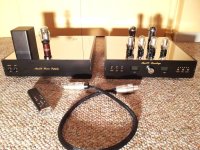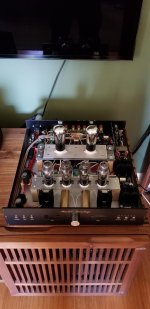Don't overlook the power supplies in "NAVAER 16-1-519", the 'Handbook PREFERRED CIRCUITS Navy Aeronautical Electronic Equipment' from 1 SEPT 1955.
If you are looking for examples of 1% and 0.1% regulation then here are some. Each one has a voltage adjustment. Voltages presented are +/- 150, 250, and 300. The book also contains a variety of other, non-power, circuits.
This book is here:
https://www.navy-radio.com/manuals/NAVAER16-1-519-1.pdf
Included are explanations of each circuit and of testing methods for the parameters given such as output impedance, and results thereof. While these circuits are for precision military instrumentation and not purposely created for hi-fi use, I found the design explanations enlightening and it was good to see the 'why' behind some circuit arrangements relating to the specifications. In addition to the text with each powr supply, this downloadable also has a bunch of design notes in the back, including for the various power suppies.
The latest edition I have seen is from April 1, 1960 and includes supplement 1,2, and 3, plus an additional notes section for many of the circuits. I have this one physically from Amazon, not found 'free' online yet, but the power supplies are exactly the same as the 1955 volume.
There is also a similar-purpose 1962 Semiconductor volume referred to as "NAVWEPS16-1-519-2". It's 266 pages, though I suspect by the plethora of PNP devices that Germanium is the semiconductor of choice. 1% regulated supplies are offered for +/- 6, 12, 25, 50, and 100V.
This book is here:
https://www.navy-radio.com/manuals/NAVWEPS16-1-519-2.pdf
There is also a later book with more circuits, including 17 semiconductor AC to DC power supplies, including silicon based designs. The circuits in this volume are all from the military labs, and the book was published by Gernsback.
It can be had here:
https://www.worldradiohistory.com/B...k-Handbook-of-Semiconductor-Circuits-1960.pdf
I have not even looked at it in detail yet but maybe it will also be helpful.
If you are looking for examples of 1% and 0.1% regulation then here are some. Each one has a voltage adjustment. Voltages presented are +/- 150, 250, and 300. The book also contains a variety of other, non-power, circuits.
This book is here:
https://www.navy-radio.com/manuals/NAVAER16-1-519-1.pdf
Included are explanations of each circuit and of testing methods for the parameters given such as output impedance, and results thereof. While these circuits are for precision military instrumentation and not purposely created for hi-fi use, I found the design explanations enlightening and it was good to see the 'why' behind some circuit arrangements relating to the specifications. In addition to the text with each powr supply, this downloadable also has a bunch of design notes in the back, including for the various power suppies.
The latest edition I have seen is from April 1, 1960 and includes supplement 1,2, and 3, plus an additional notes section for many of the circuits. I have this one physically from Amazon, not found 'free' online yet, but the power supplies are exactly the same as the 1955 volume.
There is also a similar-purpose 1962 Semiconductor volume referred to as "NAVWEPS16-1-519-2". It's 266 pages, though I suspect by the plethora of PNP devices that Germanium is the semiconductor of choice. 1% regulated supplies are offered for +/- 6, 12, 25, 50, and 100V.
This book is here:
https://www.navy-radio.com/manuals/NAVWEPS16-1-519-2.pdf
There is also a later book with more circuits, including 17 semiconductor AC to DC power supplies, including silicon based designs. The circuits in this volume are all from the military labs, and the book was published by Gernsback.
It can be had here:
https://www.worldradiohistory.com/B...k-Handbook-of-Semiconductor-Circuits-1960.pdf
I have not even looked at it in detail yet but maybe it will also be helpful.
Last edited:
I own a tube pre-amp and two mono integrated (no pre-amp neccesary) tube amps that use the OB2 tube regulator, they produce a nice purple or orange glow. It's purpose in the circuit is to regulate the voltage for the small signal tubes( in this case 6922), not for the power tubes. The power amps have an interesting power supply: they are push-pull but with a completely balanced signal path through the amp, so one amp has two separate but identical power supplies: two power transformers and associated capacitors and SS rectifiers, one PSU for the positive wave and one for the negative wave. No chokes are used, but a lot of capacity (around 1 Joule). In essence, one mono amp consist of two PSE amps with a common output transformer. Thus there are also two OB2 tube regulators for the signal tubes. I think most people think of silicon regulators but there are tube equivalents. Everything has it's best use case, of course.
Last edited:
Rectification: both PSE halves of the amp do the whole wave like a SE amp, not only half of the wave as I falsely stated, but they are combined in the OT as a push-pull amp.
I've never seen the OB2 tube regulators used on this website, but I obviously don't know every thread.
https://www.tubesandmore.com/products/vacuum-tube-0b2-voltage-regulator-diode-glow-discharge
https://www.tubesandmore.com/products/vacuum-tube-0b2-voltage-regulator-diode-glow-discharge
Attachments
I used a simple RCRCRC-filtered supply with an EZ80 rectifier for my valve phono preamplifier. While measuring low-level output signals with an oscilloscope, it was difficult to keep the trace in the picture, as it went up and down at random. I later realized that this must be due to subsonic signals on the filtered supply due to mains voltage variations.
The subsonics never bother me when the preamplifier is in normal use, but in principle, if these subsonics were to reach loudspeakers or output transformers, they might cause intermodulation products with the desired signal.
Regarding voltage regulators, most of them have quite noisy voltage references. Some filter off most of the noise with some sort of low-pass filter after the reference. Glow discharge reference and stabilizer tubes have remarkably low noise compared to a modern bandgap reference amplified up to their DC voltage.
The subsonics never bother me when the preamplifier is in normal use, but in principle, if these subsonics were to reach loudspeakers or output transformers, they might cause intermodulation products with the desired signal.
Regarding voltage regulators, most of them have quite noisy voltage references. Some filter off most of the noise with some sort of low-pass filter after the reference. Glow discharge reference and stabilizer tubes have remarkably low noise compared to a modern bandgap reference amplified up to their DC voltage.
My Aikido headphones amp (600 Ohm) with a series power supply (and slow start by means of a PY81).
Headphones Amp
Headphones Amp
Last edited:
This looks like the updated 1960 version:...
The latest edition I have seen is from April 1, 1960 and includes supplement 1,2, and 3, plus an additional notes section for many of the circuits. I have this one physically from Amazon, not found 'free' online yet, but the power supplies are exactly the same as the 1955 volume.
...
https://archive.org/details/HandbookPreferredCircuitsNavyAeronauticalElectronicEquipment
Lots of folks use glow tubes. For example, I have built a 01A DHT preamp/tube output DAC using one 0A3 and one 0D3 per channel for regulation, each channel fed by a CCS. Photos attached:I've never seen the OB2 tube regulators used on this website, but I obviously don't know every thread.
Attachments
- Home
- Amplifiers
- Tubes / Valves
- Creating High Voltage for Tube Power Supply: Serial/Shunt Regulator and Passive RC Filter Chain with Choke/Inductor; Pros and Cons

